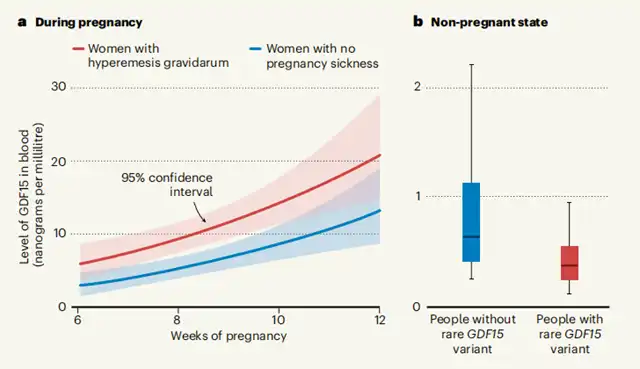GDF15 Hormone Linked to Severe Pregnancy Nausea and Vomiting Risk
- Normal Liver Cells Found to Promote Cancer Metastasis to the Liver
- Nearly 80% Complete Remission: Breakthrough in ADC Anti-Tumor Treatment
- Vaccination Against Common Diseases May Prevent Dementia!
- New Alzheimer’s Disease (AD) Diagnosis and Staging Criteria
- Breakthrough in Alzheimer’s Disease: New Nasal Spray Halts Cognitive Decline by Targeting Toxic Protein
- Can the Tap Water at the Paris Olympics be Drunk Directly?
GDF15 Hormone Linked to Severe Pregnancy Nausea and Vomiting Risk
- Should China be held legally responsible for the US’s $18 trillion COVID losses?
- CT Radiation Exposure Linked to Blood Cancer in Children and Adolescents
- FDA has mandated a top-level black box warning for all marketed CAR-T therapies
- Can people with high blood pressure eat peanuts?
- What is the difference between dopamine and dobutamine?
- How long can the patient live after heart stent surgery?
GDF15 Hormone Linked to Severe Pregnancy Nausea and Vomiting Risk
Approximately two-thirds of pregnant women report experiencing symptoms of nausea and vomiting during pregnancy (NVP). While this pregnancy-related sickness is often mild and short-lived, some women endure persistent and severe nausea and vomiting, indicating potential serious health issues. This condition, known as hyperemesis gravidarum (HG), occurs in 0.3%-3% of pregnancies and can lead to dehydration, malnutrition, weight loss, hospitalization, and, in extreme cases, pregnancy termination and maternal death.
GDF15, a member of the TGF-β superfamily, plays a crucial role in appetite regulation and metabolism. Elevated levels of GDF15 suppress cravings for high-fat diets and reduce hunger. Conversely, inhibiting GDF15 promotes fat accumulation. Additionally, GDF15, acting as a hormone affecting the brainstem, has been linked to nausea and vomiting during pregnancy (NVP) and its most severe form, hyperemesis gravidarum (HG). However, a comprehensive understanding of the underlying mechanisms has been lacking.
On December 13, 2023, researchers from the University of Cambridge and the University of Southern California published a study in the prestigious academic journal Nature titled “GDF15 linked to maternal risk of nausea and vomiting during pregnancy.”
The study reveals that nausea and vomiting during pregnancy (NVP) are associated with the GDF15 hormone produced by the fetus. The mother’s sensitivity to the GDF15 produced by the fetus forms the basis for the increased risk of severe nausea and vomiting during human pregnancy. This finding also opens up new strategies for preventing and treating severe hyperemesis gravidarum (HG).

In a groundbreaking study in March 2018, the research team conducted a whole-genome analysis of over 53,000 women, discovering an association between the GDF15 gene and the severity of nausea and vomiting during pregnancy. GDF15 hormone acts on the brainstem, controlling vomiting, and its overexpression is linked to chronic nausea and weight loss in cancer patients.
In their latest research, the team found that GDF15 levels in maternal blood steadily rise during the first 12 weeks of pregnancy. Mothers who experienced nausea, vomiting, and high blood sugar levels had significantly higher average levels of GDF15 compared to those without these symptoms.
By studying a common mutation of GDF15, GDF15H202D, where the 202nd amino acid is mutated from histidine (H) to aspartic acid (D), the researchers differentiated between the GDF15 originating from the mother and that from the fetus.
They found that higher GDF15 levels in maternal blood were associated with nausea and vomiting during pregnancy (NVP) and hyperemesis gravidarum (HG).
Mass spectrometry analysis revealed that the majority of GDF15 in maternal blood comes from the fetus, suggesting previous methods of assessing GDF15 levels in maternal blood were unreliable and failed to distinguish its source.

Analyzing carriers of rare and common GDF15 gene mutations, the research team found that individuals with low levels of GDF15 in non-pregnant states had a higher risk of developing hyperemesis gravidarum (HG) during pregnancy. The study also discovered that women with β-thalassemia, who maintain consistently high levels of GDF15 in their blood, rarely experience nausea and vomiting during pregnancy (NVP).
Based on these findings, it can be concluded that women with previously lower levels of GDF15 are at a higher risk of experiencing nausea and vomiting during pregnancy. Conversely, elevated GDF15 levels (mostly originating from the fetus) during pregnancy are associated with increased nausea and vomiting. How this seemingly contradictory phenomenon occurs is explained by the team’s speculation that individuals with naturally lower GDF15 levels may be more sensitive to the elevated levels of GDF15 from the fetus during pregnancy, making them more susceptible to its effects.
Subsequently, the research team conducted validation experiments in mice, using appetite suppression as an indirect method to detect nausea and vomiting (as mice do not vomit). Mice treated with prolonged GDF15 exhibited reduced likelihood of appetite suppression after high-dose GDF15 injections, while mice with GDF15 gene knockout showed increased appetite suppression after high-dose GDF15 injections. This confirmed the team’s speculation that the impact of increased GDF15 levels on nausea and vomiting is influenced by the pre-existing GDF15 levels in the body.
In summary, this study suggests that the sensitivity of some mothers to GDF15 from the fetus leads to nausea and vomiting during pregnancy (NVP) and hyperemesis gravidarum (HG). This breakthrough research establishes a causal relationship between GDF15 levels and hyperemesis gravidarum (HG), providing a scientific explanation for this condition. It also suggests that blocking the action of GDF15 may alleviate symptoms of hyperemesis gravidarum, and preemptive elevation of GDF15 levels in susceptible individuals before pregnancy may prevent the occurrence of hyperemesis gravidarum.
Read the full paper:
https://www.nature.com/articles/s41586-023-06921-9
https://www.nature.com/articles/s41467-018-03258-0
GDF15 Hormone Linked to Severe Pregnancy Nausea and Vomiting Risk
(source:internet, reference only)
Disclaimer of medicaltrend.org
Important Note: The information provided is for informational purposes only and should not be considered as medical advice.



